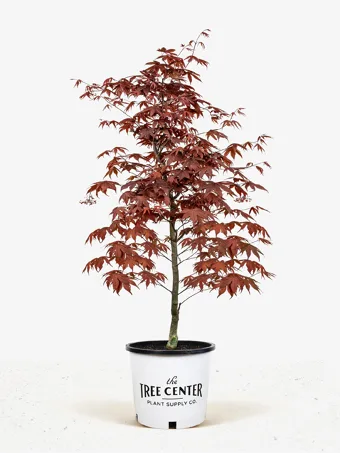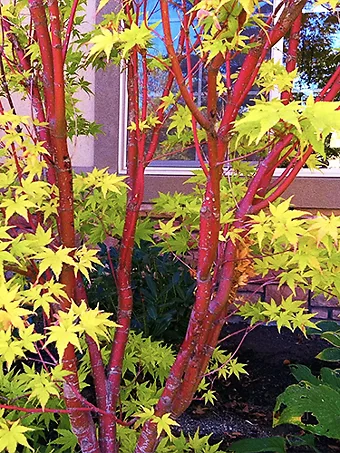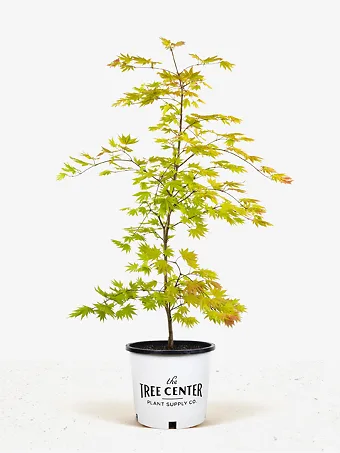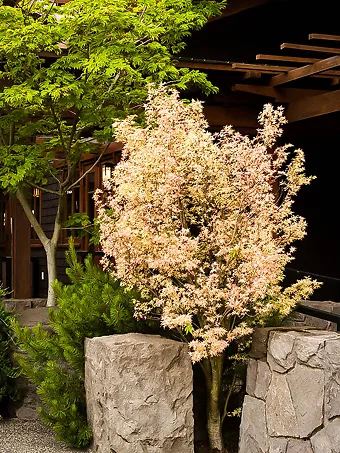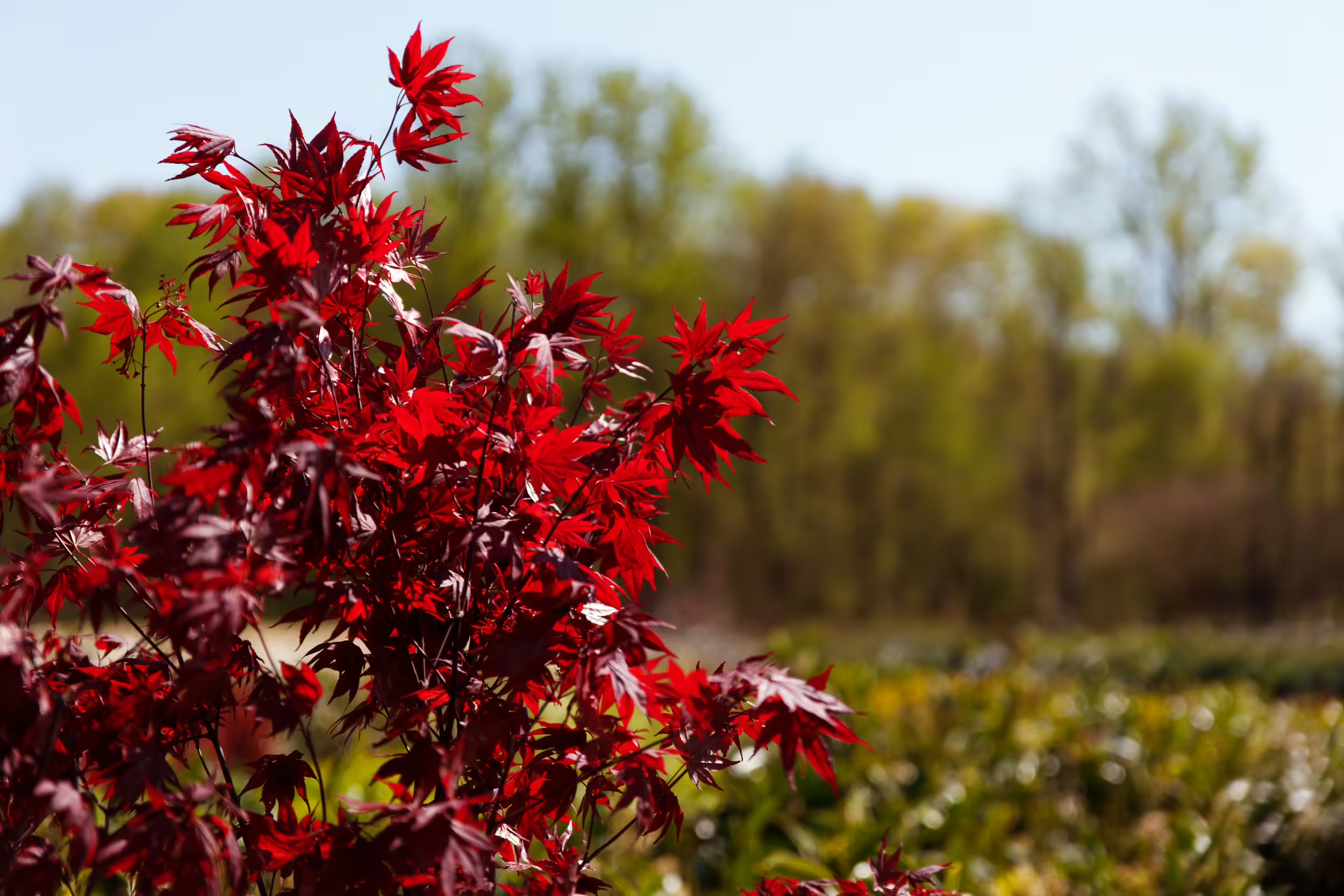
Written by s • Classic Trees for a Japanese Garden
The Japanese style of garden is enjoying huge popularity in the West. Perhaps it’s the huge interest in mindfulness and Zen, the desire for simplicity, or maybe the realization that it is the perfect style for a small space or enclosed garden. Whatever the reason, more and more people are turning to Japanese influences to create beautiful gardens. When we think of the elements of these gardens, the first thing many of us might see is raked gravel and beautiful stones, with almost no plants. This is true of some Japanese garden styles, but almost all of them do in fact include plants. Indeed, the best way to give a garden a Japanese feel is to put in the right kinds of plants – authentic ones – that immediately create the feel you are looking for. Let’s look at some of them.
Some Classic Trees for a Japanese Garden
– Japanese Maple: The most classic of all
– Pine: An essential element for style
– Plum Yew: Perfect for shady corners
– Bamboo: Avoid it taking over by replacing with Sacred Bamboo
– Hinoki Cypress: The most graceful of the evergreens
– Camellia: Glossy foliage and elegant flowers
Japanese Maple Trees
Literally nothing says, ‘Japanese Garden’ like a Japanese Maple Tree (Acer palmatum). The delicate leaves are usually divided into narrow lobes and almost look like hands. Although in western gardens the most popular varieties are those with red leaves, for a truly Japanese look, the emphasis should be on leaf shape and fall color, and green summer leaves are loved. Luckily almost all the many varieties of Japanese Maple have good fall color, so look first for interesting leaf shapes. A wonderful variety with narrow leaves that look almost like bamboo, is the Koto No Ito Japanese Maple, which really has the right ‘look’.
Japanese also love rounded forms that look like a fan, and the Fernleaf Full-Moon Japanese Maple (Acer japonicum ‘Aconitifolium’) is a rarer and high-quality tree with just that leaf shape, and worth seeking out for the most authentic look. It has spectacular fall colors of rich orange, which is an essential feature too. Any of the weeping forms is also a great choice for that authentic look, and since these are often smaller, they add a lower layer to your plant arrangement. They also look fabulous in a container, or even turned into a bonsai tree. Pick from a wide range of these beautiful trees.
Pine Trees
Pine is loved perhaps more than anything else, for its evergreen needles and rugged structure. It is almost always trained, not just allowed to grow tall, so it can be fitted into a small space. For authenticity, choose the Japanese Black Pine (Pinus thunbergii), with dark, rugged bark, or the Japanese White Pine (Pinus parviflora) which has blue-green needles, and a more delicate look. Black Pine, in particular, is very drought resistant, and so its great choice for hot, dry locations.
To give your pines the right look, use stakes to spread out the branches, and keep the crown very open, to show off the bark. Those heads of dense needles you see in the pictures don’t just happen. They are the result of a simple technique called ‘candling’ which keeps the shoots short and dense, and also keeps your tree compact so it fits into a smaller space.
In spring you will see long new shoots emerging, with very short needles. Once these shoots have grown long, but before the needles lengthen, and while they are still soft, use your fingers to snap them off to between one-half and one-third of their length. This is the ‘secret’ method used in Japan, yet it is very easy and doesn’t take much time to do. You will love the result, and you will soon see your trees become graceful and truly ‘Japanese’.
Plum Yew
This name may not sound too familiar, but this evergreen bush is widely grown in Japan. Looking a lot like a classic yew tree, and called Cephalotaxus, the great advantage of this tree is its ability to grow in full shade. Beneath taller trees, or on the north side of a wall, it is perfect. It will grow in sun too, so wherever in your Japanese garden you need a deep-green evergreen shape, this should be your choice.
The wild tree can become large, so instead choose a more compact form, like the one called ‘Duke Gardens’. Although found in America, this plant has the perfect look, and it can be clipped into the low, rounded shapes loved by the Japanese, who value neatness and order just as much as rugged natural beauty.
Bamboo
Although part of the classic Japanese repertoire, there are issues growing bamboo trees in most gardens, especially in the smaller ones where the Japanese garden look is most popular. They almost all grow very tall, and even worse, they spread and take over even large spaces. Give true bamboo a miss, and get the same leafy look from another Asian plant, the Nandina, or sacred bamboo. A wonderful feature of these bushes is their spring growth, which is often bright red. In fall many of them have vibrant red and gold coloring too, making that season so much brighter.
For height choose the classic natural variety, Nandina domestica, which will reach 6 or even 8 feet tall, with several upright stems. With lots of newer varieties to choose from you can add more color and variety, and fill the lower levels of your garden easily, as most of these grow only to about 3 feet. The variety called, ‘Moon Bay’ stays small, and it has spectacular fall coloring. The spring growth is golden, not red, so it adds variety too. To add rich wine-red foliage all year round, go for ‘Flirt’, which is only a foot or two tall – its perfect for the smallest space, or in a pot.
Hinoki Cypress
With graceful, rounded sprays of foliage and elegant branch arrangements, the Hinoki Cypress (Chamaecyparis obtusa) should be in every Japanese garden. There are so many different dwarf forms of this tree, which grows wild in Japanese forests as a tall timber tree. Many have golden foliage and bring light and brightness to your Asian-themed planting.
Some are densely structured, but other are more open and graceful, like the variety called ‘Confucius’. This is a perfect choice for an Asian garden – even the name is perfect – and its sprays of green tipped with gold bring a wonderful authentic look. The variety ‘Gracilis’ is called the Slender Hinoki Cypress because it makes a narrow column of almost horizontal branches, and it is perfect to bring height without bulk, and fill a corner of your garden.
Camellia
Finally, no Japanese garden would be complete without a Camellia Bush. The Japanese people love flowers, and the delicate look of the flowers on a camellia are highly prized. As well, tea comes from a species of camellia, so having one growing creates a subtle association. Choose flowers that are more delicate and open, not the strict ‘formal’ flowers of many Western varieties.
The camellia known as ‘Kanjiro‘ was bred in Japan, and it has a more open form that fits in better than the dense shape of many Western varieties. It blooms in fall, and it is the perfect ending to the season. The open flowers are a swirl of deep-pink petals around a golden center. You can contemplate their beauty will sipping green tea in your authentic Japanese garden.
